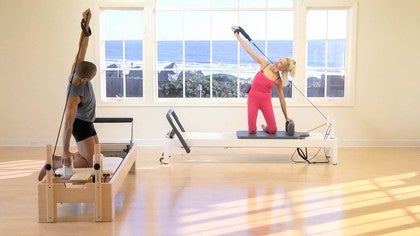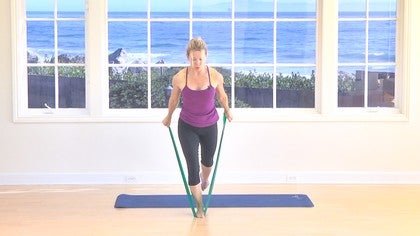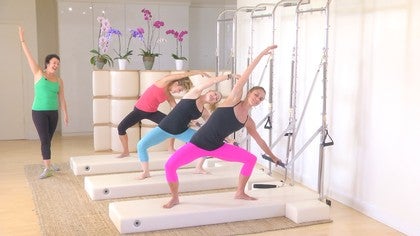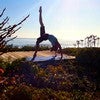Description
About This Video
Transcript
Read Full Transcript
Welcome to Pilates Anytime. I'm Elizabeth Larkam, delighted to be back with you on Pilates Anytime. I'm here with my colleague, Norris Tomlinson. Norris is the owner of Sirron Pilates in Chicago. And we're here to work with you on a program that excellent for correcting laptop neck and computer shoulders.
In this day and age, thoracic flexion and cervical hyperextension is so unattractive and so common because the eyes are the advanced team of the spine. And where the eyes go, the gaze goes. Where the gaze goes, to head goes. Where the head goes, the neck goes. Then there goes the spine, and there you go.
So we're going to do a series of moves today that will help you reconnect with getting over the slump, moving in the direction of spine extension. We're going to start with a lateral translation of the spine. The lateral translation is a gateway to the rotation, which is in turn is a gateway to extension. I know-- a lot of words. And I would trust it'll make sense in movement as we go.
So we're going to start first using this Pilates Allegro II Reformer from Balanced Body. That has a number of adjustable parts that I'll make use of. So here you are with no springs whatsoever on the carriage. I'll bring the foot straps down because I won't be needing those for this exercise. Neither at this moment will I need the shoulder rests.
Now, if your shoulder rest do not attach, please don't despair. Just leave the shoulder rest there and move them out of the way of the client. I'll be able to take them off right here. You can see now that the carriage has no springs and can easily slide back and forth. You can also see that Norris has a box, a platform, such that the platform is the same height as the carriage.
Now please come to lie on your back with your pelvis on the platform, your ribs, head, and shoulders in contact with the carriage. It will be just fine to have the back of your waist, L3, on nothing. So right opposite to your naval spine, there's a space there. And you're in a neutral pelvis, neutral spine. Now crossing your arms across your torso so that the weight of your ribs rests heavy on the carriage.
I'm going to put my hands over the front of the ASIS in order to help to stabilize the pelvis. It's not necessary to do this with a partner. if you have an instructor available, they could help you with this. Otherwise, you'll be very safe on your own. Anchoring the back of your pelvis, slide your ribs towards the left side.
That's right. Inhale to the back of your left lung, exhale to come to center. As you inhale to the back of your right lung, slide the carriage to the right side and come back to center. Continue this action. As you slide to your left, I'm keeping your right ASIS steady-- and come back to the center and then slide to your right.
The idea is to create a parallelogram-- continue-- a parallelogram-like relationship between the ribs and the pelvis, lengthening the connective tissue of the quadratus lumborum and then other structures that connect the ribs and the pelvis. Now it's every client's tendency to move into side bending. So do your best to filter out the side bend and keeping your collar bones level and steady as they go across. Now, keeping the back of your left pelvis steady, cross your whole right thigh over your left thigh, crossing over there, and again continue this action of this side-to-side shift. As you do this, create a neutral pelvis, a neutral spine, and keep the back of your ribs-- the back of your lungs-- heavy down onto the carriage so that you are coordinating this motion through the sling system rather than poking your ribs towards the ceiling.
Uncross the current thigh and cross the new thigh on top. When your left thigh is over, it will be easier to move to the right and come back to center. Inhale. A lateral translation to the left. Meanwhile, the chest bone is heavy down onto the carriage.
Last two coming up. I'm pressing more strongly with my right hand when you go to your right. I'm pressing more strongly with my left hand when you go to your left, doing your best to edit out the side bending. Uncross the current thigh and now place the soles of your feet on to me. So here I am functioning as a wall.
Stand firmly here, press strongly with your right foot, and slide your ribs to the left and come back to center. Press strongly with your left foot and slide your ribs to the right. Press and go the opposite way, right, inhaling. Now if all is going reasonably well, I'm just going to reach across here and put a little bit of tractioning. Sliding to your left-- that's right.
Sliding to your right. Long on the right side of your spine as you go to the left. Get on over there, Norris. That's right. Push with your foot.
Push with your-- that's right. Create a ground force. That's fine. That's your easy side. We knew that.
Press with your right foot and move to the left. Press with your left foot and move to the right and press with your right foot and move to the left. Now put the soles of your feet down. And if you have a helper-- that would be me. Give me your hands.
Roll up from here and it's time to spin around. Turn around now so that your pelvis is on the carriage and your feet are on the carriage also. That's right. And we're going to just adjust this platform so you have some cushion for your head. Come to lie-- woo, I'm going downhill fast-- coming to live on your back.
That's right. So here we are. Let me turn this around just a moment so they support your head and we need to move this down underneath your ribs-- OK. We're back with you now at a better angle. You can see that Norris has his pelvis and his feet supported by the carriage and the rib, shoulder, girdle, and head supported as well.
You can see also that I've put a couple of towels underneath Norris's head-- better to have a little pillowing of the head that encourages the chest bone to glide more easily towards the pelvis and helps to put the person in better contact with their abdominal sling system rather than the spine sling, the back of the body sling system. That has a name-- it's posterior oblique swing system. Now it's my job as the helper, the instructor, to put my hands around the hip crease here and put a little bit of traction so that now-- Norris shift to your left, lengthening the left side of your waist, exhale to come to center. As you inhale, shift to the right side. Exhale-- come to center.
Inhale to the back of your left lung and you'll shift to the left. Inhale to the back of the right lung and you'll shift to the right. Now, for the next variation, keep your left leg exactly as it is and cross the right thigh over. When your right thigh is crossed over, I'll put a little bit of traction, aiming my sitting bones back. Lengthen the left side of your waist and come to center.
Inhaling, lengthen the right side of your waist. Even though this has no springs attached and it's not a strength exercise, it's quite beneficial in terms of addressing the ease of mobility of the thoracic spine and of the pelvis. And as I mentioned, lateral translation is a gateway to side bending, which helps with our rotation and extension. Now uncross the current thigh and plant the soles of your feet on to me. So here you are standing firmly to here but not too firmly or else I'll go backwards.
When you were lying on your ribs on the carriage, you were pushing with the opposite foot to move. Now you push the same side foot. Push with your left foot and you'll move your pelvis to the left. Push with your right-- that's your left foot, sorry. Push with this left foot on my right and slide to that side.
That's right. Come back to center. Inhaling, aiming your tailbone towards the left and come center-- inhaling, aiming your tailbone to the right. And I could help make the movement a bit more accurate if I provide some tractioning this way. So you lengthen the side of the waist to which you were going and lengthen here.
Correct. Pressing with your right heel, you slide up this way. And you slide over that way. Now take your feet off me, put your feet on the carriage, roll up here, and here we go. So now-- hours of entertainment with that-- as fascinating is that is, it's time to move on to the two Reformer workout coming right up.
We're back with you now for bridging. You can see that the head rest is down, and we have two red springs on. So come to your side, slide both sitting bones off the edge, and roll on to your back. Place the heels very wide on the foot bar, inhale to prepare. As you exhale, scoop in above your pubic bone, peel your pelvis and spine up, letting your lungs rest into the basket of your ribs.
As you inhale, aim your knees towards each other and roll down your spine, each vertebrae getting its own turn to rest down on the carriage. Keeping your knees towards each other as you exhale, scoop in above your pubic bone, peel your pelvis and spine up. And then wide between your knees, roll down your spine-- each vertebrae getting its own turn to come down. Inhale to prepare. As you exhale, peel your pelvis and spine up.
Now aiming your knees towards the midline, push back. And knees wide, come forward. Again, knees towards the midline. Push back and forth twice more. Back of your pelvis wide and sitting bones narrow-- sitting bones wide.
Reverse now. Keep your knees wide as you push back and knees narrow as you come forward, sitting bones towards each other, sitting bones wide. Shortening across the posterior pelvic floor and broadening. Last two coming up and last one. Keeping your knees toward the midline, roll down your spine.
Each vertebrae gets its own turn. Inhaling-- knees wide apart. As you exhale, tilt both knees to your left, peel your pelvis and spine up. As you push back, turn your knees to the right and then turn your knees to the left. Now turn your pelvis and lumbar spine to the right and then rotate your pelvis and lumbar spine to the left.
Rotate and push. Now although I continue with one more on this side-- although I'm turning my head-- reverse. Knees to the left and knees to the right. Is that the reverse or it's not? It is.
Oh good, OK. Now you ought to be keeping your head, neck, and eye directly at the ceiling. I'm turning my head to look at you, and that breaks the Pilates rule number 405-- don't be turning your head to the side when you're up in a bridge. One more here. Come all the way forward.
Knees towards each other. Roll down your spine. Each vertebrae gets its own turn. Now place the front of your left heel in contact with the foot bar and your right toes are suspended from the ceiling as if by fishing line. Inhale to prepare.
As you exhale, it's a posterior pelvic tilt and spine flexion-- press up. Now keeping your right toes, aiming exactly to that place on the ceiling, turn your pelvis and lumbar spine to the right as if you were unscrewing the light bulb of your right foot from the ceiling. And then as if your right leg was a corkscrew, bring your right toes closer to this ceiling. When the pelvis and lumbar spine turn to the right, the right side of the pelvis comes, the back of the pelvis touches down. When you inhale, bring your toes towards the ceiling-- twice more-- turning your pelvis around the femur head on the left side, using rotation of the pelvis and the lumbar spine.
Bringing your right toes towards the ceiling, roll down your spine. Each vertebrae gets a turn. Bring the front of your right heel on to the foot bar, your left toe suspended from the ceiling. As you exhale, peel your pelvis and spine up, planting the front of your right heel firmly into the bar. Now rotating your pelvis and lumbar spine to the left, the back of your pelvis comes to touch the carriage down on the left.
You left leg is in external rotation-- inhaling, bringing your left toes towards the ceiling, turning your pelvis to the right. Exhale to turn down to the left. Inhalation facilitates the motion into extension. Twice more-- down on the left as if your leg was a corkscrew rather than a windshield wiper. Last one-- aiming your left sitting bone towards your right ankle.
Come towards the center and roll down your spine. Each vertebrae gets a turn. Roll to your side and come out from here. Now we're into side bending. So please change to a yellow spring on the top and take your two reds off.
We have one yellow spring at the top. Now come to kneel out and reach for the loop from the back. So here you are kneeling with knees at the center line of the carriage-- front to back and right to left. Take the loop from the back and this loop from the back is going to be around your far wrist. That's, in our case, the hand that's closest to the springs.
So take the loop around your wrist like so and lean on to the heel of your hand with your elbow up towards the ceiling. Now here you are in side bending-- a long distance from your right elbow towards your right knee. As you inhale, turn to see the ceiling. Exhale-- turn to see behind you. Press through the heel of your hand and turn to the ceiling and turn back.
Twice more. You can see that the intention here is to keep your elbow bent as if you had a parasol or an umbrella to shade you from the sun. Now once you're here, now it's time to straighten your elbow and come back. Exhaling-- shoulder blade comes down your rib wall. Inhaling here.
Twice more-- exhale to press. Inhaling-- moving your gaze down. Exhaling-- drawing your shoulder blade towards your pelvis. Change now to the new hand. Now it's your new hand, the one that had been on the shoulder rest.
You have options here. You always have options. You can place the short loop across your palm. You could also place the long loop across your palm. It will be less demanding on your shoulder joint if you use the long loop-- more demanding for the whole length on the left lateral side.
Bring your knees close together and slide your palm along your thigh. As you exhale, bring your ear over to listen to the carriage and straighten your arm up next to your ear. Inhale to reach over. Exhale to bring your fingers down towards the carriage. Inhale-- reaching over.
Have the intention that you could drape your fingers over the spring edge of the carriage. Inhale to reach. Exhale to lower. Stay in side bending. As you bend your elbow, look down at the springs.
And as you extend your arm, turn your ribs, head, neck, and eyes to see the ceiling. Bending your elbow, look down at the ground. Turning to look up. Twice more. Lots of side bending here and some rotation also.
Last one coming up. Now come up to vertical. Reach the ceiling and then bend your elbow, come down from here. Park this loop and turn to the other side. Here you are on the new side.
You have the option of taking the short loop from the back or the long loop from the back or the short loop from the back. Here you are with your hand resting on the shoulder rest. It will be less demanding if you have your hand on the front shoulder rest and more demanding if you have your hand on the back. Give yourself a wide base with your knees on this one and come into side bending. Poking your elbow up in the direction of the ceiling-- as you inhale, turn to see the ceiling next to your elbow.
As you exhale, turn back and see your feet. Inhale-- turning your pelvis, ribs, shoulders, neck, head, and eyes. Exhale to return. Plant the heel of your hand firmly into the shoulder rest to give you a ground force with your hand. And as you inhale, do collect your lowest ribs towards your pelvis so that you have length at the side body and don't spill into hyperextension.
Now change to the new hand. That'll be the long loop or the short loop and bring your knees closer to each other. Sliding your palm along the outside of your thigh, bring your ear to listen towards the carriage. And it's your top hand-- reaches over, beyond the foot bar. Exhale.
As you inhale, reach towards the foot bar. Exhaling, fingers drape over the edge. Inhale to reach. Exhale to come further. Now stay over here in side bending.
Bend your elbow and straighten your arm alongside your ear. Inhale to bend. Exhaling. When you exhale, you can turn your head, neck, and eyes to look down. When you inhale, see the ceiling above you.
Exhale-- see the floor below you. And once more-- finding your shoulder blade, drawing it down your spine before you take your arm up next to your ear. Come all the way up to vertical, bend your elbow and come down from here. Now park these loops and we're going now to semi-circles. So for that, we're going to bring the foot bar down initially.
And we'll go to a red and a blue spring. Here you are making those adjustments. Great. Norris is bringing his foot bar down. That's an option.
I'm going to leave mine up. We're going to not need the foot loops, but we'll just leave the shoulder rest where they are. Slide down so that both sitting bones are off the edge, come to lie on your side, and come on to your back. Now you have the front of your heels in contact with the foot bar, and it's time now to get into the position for semi-circles. So press the heels of your hands onto the shoulder rest and lift your pelvis and shimmy on down until you elbows are straight.
I apologize. I left an extra spring on. My mistake. I just need to get it off. Woops-- all righty.
You know, always blame the environment. If something goes wrong, think it's not that my arms are not strong enough. It's just I left an extra spring on, which is true. Given the option, always blame the environment. However, if you're the supervising instructor, it's ultimately your responsibility.
I know that. With your heels wide apart, as you exhale, knees towards the center, bringing your pelvis down into the springs. Spring cleaning-- slide your pelvis along the springs, knees wide. Now it's a posterior pelvic tilt and spine flexion. Knees towards each other-- push back.
Now it's an anterior pelvic tilt and spine extension. Knees wide. Knees towards each other. It's a posterior pelvic tilt. Push back and knees wide.
It's an anterior pelvic tilt. Knees towards each other-- posterior pelvic tilt. As you push back, move your shoulders away from your neck. Now as you externally rotate, push further away with your hands and pour your ribs down into your pelvis. Slide on in.
Posterior pelvic tilt and spine flexion-- pushing back. Anterior pelvic tilt-- pushing away and spine extension. Last time-- gliding your ribs towards pelvis, push back. And aiming your sitting bone and your tail bone down into the springs, stay in the springs and reverse. Exhale to push back.
Internally rotate-- lift your pelvis up and aim your knees towards the center. Externally rotate-- push away with both hands while you sit into the springs. Internal rotation, posterior pelvic tilt, and spine extension coming forward. Knees apart, sitting bones narrow as you sit down into the springs. Knees towards each other.
Sitting bones come up. Once more, pour your ribs into your pelvis and your pelvis into the springs. Scoop in and bring your pelvis forward and up. Aiming your knees towards each other, slide the carriage underneath you. Come all the way up from here.
Now it's at this moment that we're going to diverge paths because the Allegro II has an Infinity foot bar that can slide to different ends. And at this moment, Norris is going to come onto the Allegro II Reformer and do some overhead arm work while I do a similar exercise on the Studio Reformer. Now to focus on the organization of your shoulder girdle, you can see that Norris is on his back. And he has his hands wide apart on the Infinity foot bar. That's a blue spring on the carriage, and knees are into his torso.
Meanwhile, if you have access to an Infinity foot bar and your Reformer, by all means, follow along with Norris. If, however, you are more accustomed to the foot bar staying in its more conventional position, then you'll be following with me. As you exhale, slide your shoulders down. And I'll cue me because Norris's work is fairly straight ahead. Nod your nose downwards, see your knees, see your thighs, see your hip joints.
And arms go up alongside your ears, and arms go wide to the side with a little bit of elbow bend. As you exhale, arms sweep out to the side. Inhale to come down. Nod your nose downward, roll your head, neck, and shoulders up. So you can see here that we're combining the conventional Pilates mat and Reformer exercise, the roll down, in conjunction with some arm work.
Exhaling-- nod your nose downward, see behind the cheekbones of you face, and roll right on up. Now adding rotation, turning to see over your shoulder and roll down the side of your spine. Arms go up alongside your ears. Maintaining the rotation, nod your nose downward, see over your shoulder, and roll on up from here. Coming through the center, turn to the new side, turning your left lung to the right, the right lung behind you to the left.
Go down gradually-- the right side of your spine in contact with the roller and then nod your nose downward. Roll you head, neck, and shoulders up. Arms go up and open. Now I'm going to park these loops and take an overhead arm press. So this would be the material that's more closely related to what Norris is doing.
Inhaling, I'll press arms above the head. The inhaling to press out makes it more likely that you'll be able to keep your thoracic area down towards the roller. Turning head, neck, and eyes to see past one elbow and turning your head, neck, and eyes to see past the other elbow. When it's time for one arm at a time, you can rest one hand on the carriage or one hand on your abdominals or reaching up-- good luck to us-- reaching across towards the ankle, the shin, the ankle, or the big toe. Creating a ground force with your pelvis with the back of your sacrum, turning your head to look away from the supporting hand, and then turning your head to look towards the supporting elbow.
Then the new side awaits. Crossing the new ankle, shin in front. Your arm can be down on the carriage or resting at your pelvis or reaching across to your shin, ankle, or foot. Turning your head, neck, and eyes to look away from the bending elbow and turning your head, neck, and eyes to look towards the bending elbow. Now when both hands are wide apart-- join me here, Norris.
When both hands are wide apart, you have the option. If you'd like, of taking the Pilates mat exercise the Roll Over. So pressing the heels of your hands into the bar, curl your pelvis up, posterior pelvic tilt and spine flexion. The soles of your toes can go towards the bar or in Norris's case, as you like. Your legs can slide underneath the bar, coaxing a little bit more length to the superficial back line, all the connections from the soles of your feet towards the top of your head.
Press away with your hands, bend your knees a little to be kind to your spine. Roll your spine and your pelvis down. Now, Norris, you can roll to either side and come up to sitting, and I'll plant my feet and interlace the fingers. Nod your nose downward, roll your head, neck, and shoulders up-- reaching your hands towards the pulleys-- and come all the way up to vertical. Now for the next event, Norris and I will switch back to the conventional locations and be right back with you.
So we've addressed spine flexion and rotation, and now it's time for combining flexion, extension, and rotation. Norris has a red spring at the top and the foot bar quite high to do his work in extension and rotation. I have a yellow spring. And clearly, the Infinity foot bar is at its far end. So you can follow along with Norris or follow along with my cues.
Inhale to prepare. As you exhale, slide your shoulders down. Bring the pelvis into a posterior pelvic tilt and spine flexion. Now right about the time that your femur has come to vertical, you move into an anterior pelvic tilt and spine extension. Lifting your chest bone, your gaze up to see the ceiling and to see the ceiling behind you.
Leaning back with your sitting bones, the light from your chest bone comes across the ceiling, across the wall, across the ocean, and down. Inhale to prepare. On the exhalation, it's shoulders descend. It's a posterior pelvic tilt and spine flexion. Unfurl your spine.
Bring your pelvis over the top of your femurs, broaden across your collar bones-- still collecting the lowest front ribs towards your pelvis. And then move back, aim your sitting bones up and back behind you. We'll do one more of these in the sagittal plane and then add rotation. As you exhale, slide your shoulders down, tuck your pelvis under, unfurl your spine. Still connecting from pelvic floor up behind your chest bone, broadening across your collar bone, keeping the back of your neck long-- see the ceiling above and behind you.
Lifting your chest bone and your gaze, spread your sitting bones wide as you come back. Now to add rotation, I'll take my right palm up and left palm down. Inhale to prepare. As you exhale, it's a posterior pelvic tilt. Unfurl the spine and now it's rotation as demonstrated earlier.
See the ceiling where the ceiling and the wall meet in the far corner and then lead back with your pelvis. Pelvis leads the way. Inhale to prepare. As you exhale, your right hand comes towards you. Your left hand pushes down and then lifting your chest bone, moving your lungs around your central axis, see the ceiling above and behind you and come back.
Change now to the new side. Right hand is palm down in the center. As you exhale, it's a posterior pelvic tilt and spine flexion. Unfurl your spine, lifting your chest bone and your gaze. See the ceiling where the ceiling and the corner of the wall meet and lead back.
Inhale to prepare. Exhale, curl forward-- posterior pelvic tilt. Unfurl your spine, moving your pelvis high over the top of your femurs, rotating around your central axis, and lead up with your chest bone, back with your pelvis. To finish off this situation with a sagittal plane, without rotation, exhale to come forward-- in flexion. Just a note-- you could certainly, when it's time to come into extension, change your arms-- palms up.
And the external rotation of your arms facilitates the extension of the thoracic spine-- sneaking your hands palms down upon return. Now I'm going to keep the foot bar in its current location, and Norris will switch to lower the foot bar just slightly. We'll be right back with you. Once again, Norris and I are doing complimentary moves. Norris is doing the long back stretch with the foot bar at its lower position and the red spring attached.
I'm sitting on the Infinity foot bar with feet over the shoulder rest, using a yellow spring. Go ahead, Norris. And I'll cue myself. As you exhales, slide your shoulders down and hover your pelvis. Now keeping the pelvis suspended, do a hamstring curl, bringing your heels towards your sitting bones, bending your knees.
This is the first variation here-- keeping your pelvis lifted. As you get familiar with this, slide your feet over the shoulder rests. And as you bring the shoulder rest towards you, press your pelvis forward, lifting your chest, and lifting your gaze. So we have scapular depression, some length of the superficial front line, some length of the deep front line. And this would be having the intention of thoracic extension.
Broad across your collar bones. Remember, your eyes are the advanced team of your spine. So as you become familiar with this, you can look up and back to the ceiling above and behind you. Last two coming up. And last one.
Easy now on the dismount. Have a seat and slide the carriage down. Now I'm going to do the roll down on the carriage with Infinity foot bar while Norris uses the box for the advanced box work, including "around the world." So while I reset my foot bar, Norris will get the box. Join me to take a look at how to set this foot bar. You'll move the foot bar up and back towards the risers and then slide the foot bar forward until you can see that the indicator is just pass the dimple.
Now bring the foot bar to its upright position, slide it into place, and make sure that it's locked right there. Additionally, I'm going to take the shoulder rests off so they won't be in my way. Put them right down here. Norris has his feet secure underneath the foot strap, and I'm going to use one red spring. Now for this, I need to have some non-skid pads.
Here's why that is-- if I don't have any non-skid pads here, then as I pull forward like this, I also slide along here. Sitting with both sitting bones at the spring edge of the carriage and hands wide apart, inhale to prepare. As you exhale, slide you shoulders down, roll back, bringing the front of your abdominals towards the back of your spine. Inhaling here. Exhaling-- look down behind the cheekbones of your face and roll forward.
Next variation-- turning your arms palms up. Inhaling, you chest bone leads towards the ceiling. It's spine extension, broad across your collar bone. See the ceiling just above and behind you and come forward, rounding forward. Next variation is flexion with rotation.
Dorsiflex your feet when you're rolling back inflexion because the dorsiflexion will activate the deep abdominals-- coming back into spine rotation and then curl forward, bringing the left cheekbone, in my case, towards the right sitting bone. Change your arms-- right palm down and left palm up. Exhale to roll back, moving your shoulder blades down your spine at a more rapid rate. Then you move your spine itself. Shoulders descend, collar bones widens.
First side again, planting both feet because plantar flexion-- pointing your toes will do a better job of activating your spine extensors up and back there. And keeping your spine in extension, come up and forward, passing through the center with spine flexion. Inhaling-- up and back. Exhale to come forward. Start the whole project again.
Dorsiflex your feet. As you exhale, it's spine flexion and a posterior pelvic tilt. Arms are palms down because palms down is more supportive of thoracic and cervical flexion. Now turning your arms palms up because external rotation at the shoulder joint is paired with lumbar, thoracic, and cervical extension. Of course, all of these exercises involve an integration of the front, the back, the sides of the body.
As you exhale, it's flexion and rotation-- broadening across your collar bones. Inhaling here and flexion with rotation. This time, you can stay on the current side. It's extension with rotation-- and coming back up. And then the other side, it's flexion with rotation, integrating all the myofascial meridians-- the front of the spine, the back of the spine, the side body, and the spiral line.
Come all the way back to the middle. Now we will finish this program was some standing exercises. And for that we'll get rid of the box. And I'm going to bring the foot bar back to its conventional position and put the foot bar down. For this, we're going to use a blue spring-- so one blue spring, no more red.
And we'll both need shoulder rests. So I'll put the shoulder rest back in and get rid of the non-skid mats. You'll be standing, facing this side of the carriage. And you'll bring the leg that's closest to the shoulder rest-- put that leg in parallel next to the shoulder rest. And here you are in parallel.
Now slide to the side and slide right back in. As you exhale, sliding out, aim your sitting bone towards the opposite ankle bone in order to ensure that there is length at the side of your waist. Slide out. You remember when Norris started this program, he was working in lateral translation just to make sure that he could have equal length on both sides of the pelvis. Now, bending your knee, as you exhale, extend your leg and slide out.
While you are out, bend your knee in and then send it away. Inhale to bend, exhale to push away. You have options. You can have the sole of your foot pressing straight down. You can also, if you'd like, angle your foot just slightly up the shoulder rest.
Choose the one that's best for your ankle and best for your knee. Now we'll add on to this with a side bend stretch. Pick your arms up and take a hold of your elbow, your forearm, or your wrist and fingers. Now reaching up towards the ceiling and over towards your foot, side bend. Bend your knee and send it away, reaching your fingers towards the risers, towards the upright, taking the longest distance all along from the little finger side of your hand to the little toes side of your foot.
Now when it's time to return, keep the carriage out by the risers for as long as you can. Keeping the carriage out, shift your pelvis towards the foot bar. Shift and reach, shift and reach. Taking the longest distance, over and over and over and side bending, coaxing length of the lateral line. Bring yourself all the way up to vertical and it's time for the new side.
So here we go changing to the new side. I'll walk around here. Place your supporting foot so it's even with the spring edge of the carriage and your working foot along the carriage next to the shoulder rest. Now if it seems to you that the height of the carriage is not optimal for your leg length and the ease of motion of your hip joint, by all means, put a firm pad underneath your supporting foot on the floor so that you'll have the right distance and not be too stressed with your hip joint. Hands at your pelvis at first, exhale to slide out, inhale to go further, and then slide right back on to your hip joint.
You have the option of bending your knee when the carriage is in, straightening your leg-- slide out. Each time coaxing a little bit further in abduction and come back in. This time we'll stay out, push out, slide out. While you're out there, bend your knee and then send it away. For stability, plant the sole of your big toe firmly on the ground and have the intention of leveling your pelvis by aiming your sitting bone to your opposite ankle bone.
Come all the way back in. Now take both arms up and the hand closest to the foot bar reaches towards the ceiling. The hand from the risers takes a hold of the opposite hand, wrist, elbow, and lift up and over, reaching your hand towards the risers. Slide the carriage out. While you're out there, bend your carriage knee and send it away.
Here's some new information. While you're over here in side bending, you can rotate, turning your floor lung towards the ceiling so you're side bending and rotation-- taking the longest distance from the heel of your standing foot towards the little finger side of your hand. Two more here-- coaxing a little bit more length. Now keeping the carriage leg straight, pull your hand up and over to the risers and shift your pelvis towards the foot bar. Reach and shift, reach and shift-- coaxing a little bit more length into your entire side body, taking the longest line possible from the heel of your foot to the heel of your hand and beyond.
Come all the way up, bending your knee. Come on in and have a seat on the carriage. Thanks ever so much for joining us. I look forward to being back with you another time on Pilates Anytime.
Back Care: Improve Your Posture
Comments
You need to be a subscriber to post a comment.
Please Log In or Create an Account to start your free trial.
































